Birdsong I need practice to learn!
Decision table for identifying birdsong
| Bird | Description | Audio |
| stereotype melodic | ||
|
|
stereotype melodic slow high (4-7 KHz) .
General: It sounds to me like a 5-7 note song like 'five k low high higher', 'short song in the gar-DEN'. The individual notes have the same backward checkmark shape as the call. It's basically the same across Europe. Song: |
♫

|
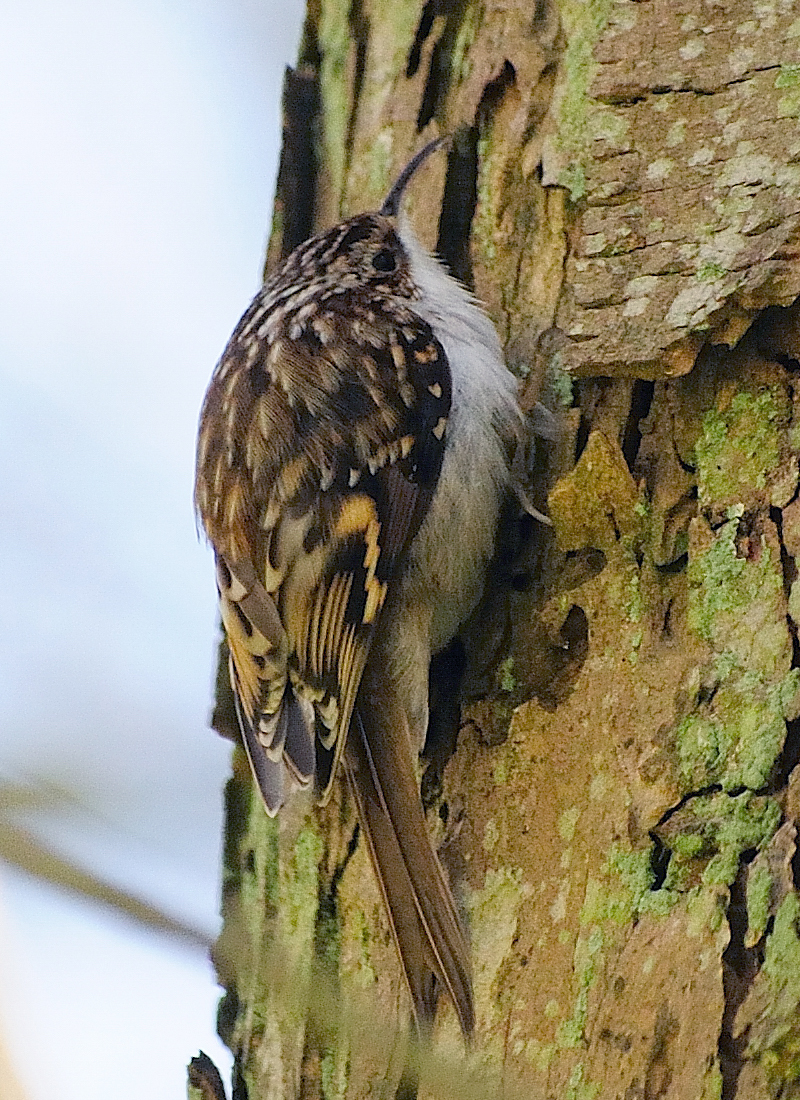 Eurasian treecreeper Sagging tree branch ■■
Eurasian treecreeper Sagging tree branch ■■ |
stereotype melodic slow medium (1-5 KHz) .
I say: it sounds like a faster higher chaffinch song. Wikipedia says: The male's song begins with srrih, srrih followed in turn by a few twittering notes, a longer descending ripple, and a whistle that falls and then rises.
Song: |
♫

|
| improvised melodic | ||
| weird, rasp | ||
|
|
weird, rasp improvised melodic fast low-high (1-7 KHz) .
Wonderfully weird sequence of chirps, cheeps, growls. Elements often repeated twice. In a quiz, I mistook it for a starling. This recording reminds me of other water songbirds like the Marsh warbler and various reed warblers.
Song: |
♫
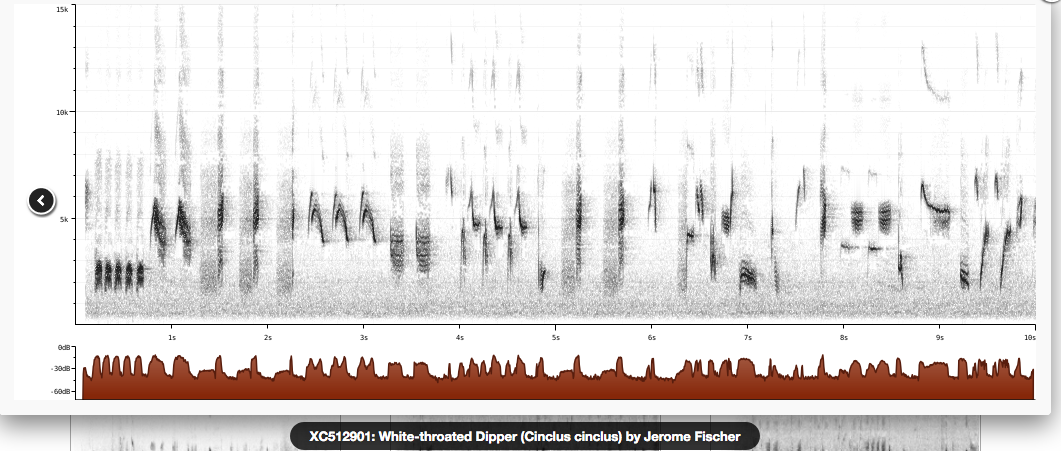
|
| sings 30 seconds or longer | ||
| weird | ||
|
|
weird sings 30 seconds or longer fast medium (1-5 KHz) .
Weird, squeaky, urgent. Slower than Sumpfrohrsaenger.
Song: |
♫

|
| mimicry, weird | ||
|
|
mimicry, weird sings 30 seconds or longer fast medium (1-5 KHz) .
Weird, squeaky, urgent, more variable than reed warbler, with imitations of European and African birds.
Song: |
♫

|
| rasp | ||
|
|
rasp sings 30 seconds or longer slow medium (1-5 KHz) .
General: Sounds to me like croak cheep cheep!
Listening on YouTube videos, you'd call it percussion rather than song! Song: |
♫

|
| one note | ||
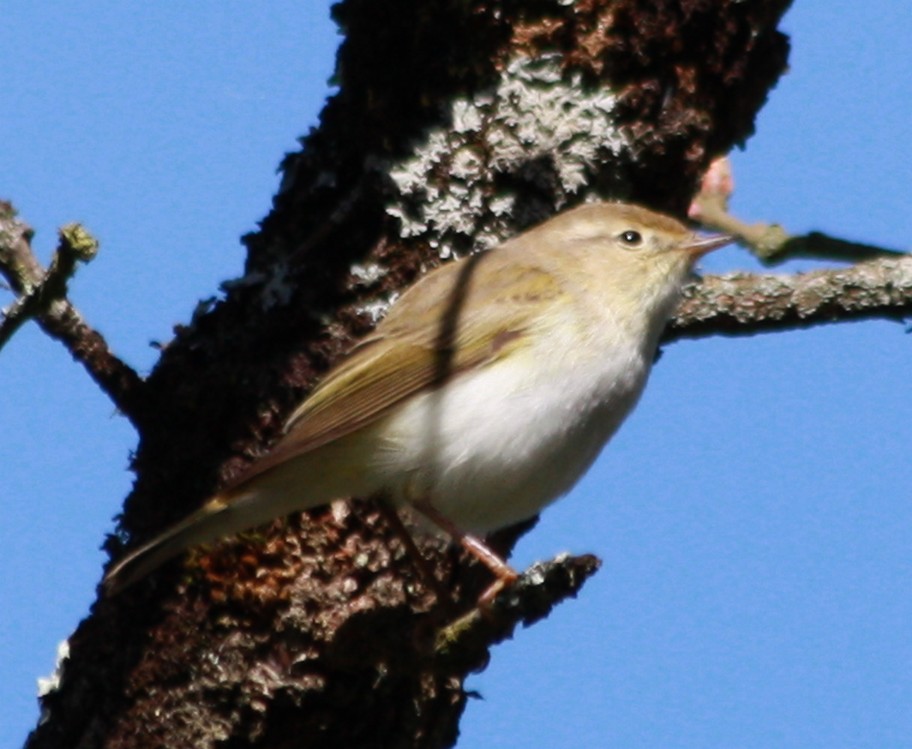 Western bonelli's warbler ■■
Western bonelli's warbler ■■ |
one note fast high (3-7 KHz) .
Single note repeated 6 or 8 times quickly in half a second
Song: |
♫

|
| improvised melodic | ||
| whoop, weird, trill | ||
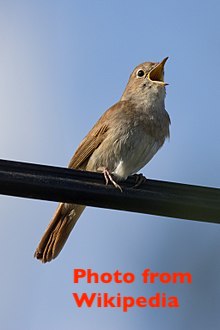 Common nightingale ■■
Common nightingale ■■ |
whoop, weird, trill improvised melodic slow medium (1-5 KHz) .
Can be a sequence of unrelated weird but musical sounds - trills, churrs, human-like whistles - very amusing.
Song: |
♫

|
| two notes | ||
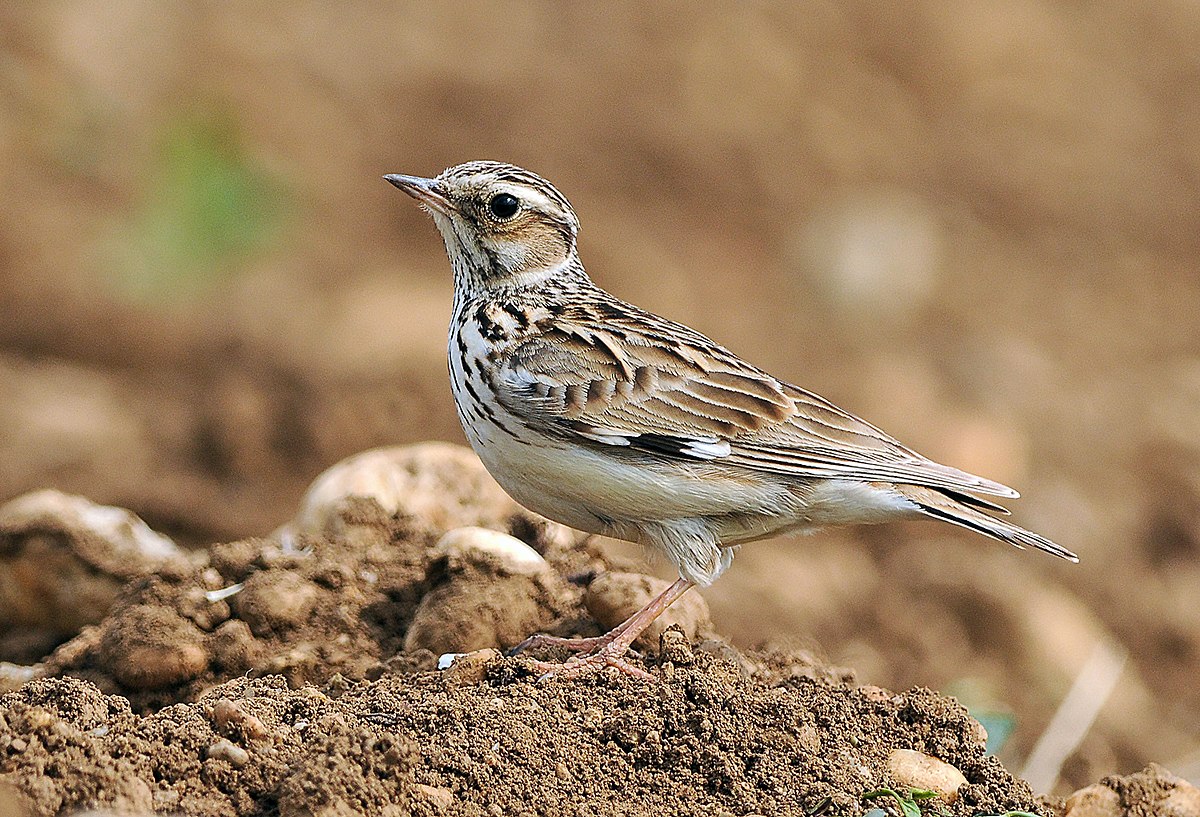 Wood lark ■■
Wood lark ■■ |
two notes fast medium (3-5 KHz) .
General: Slow for a lark? Fast to me. Song: |
♫

|
| stereotype melodic | ||
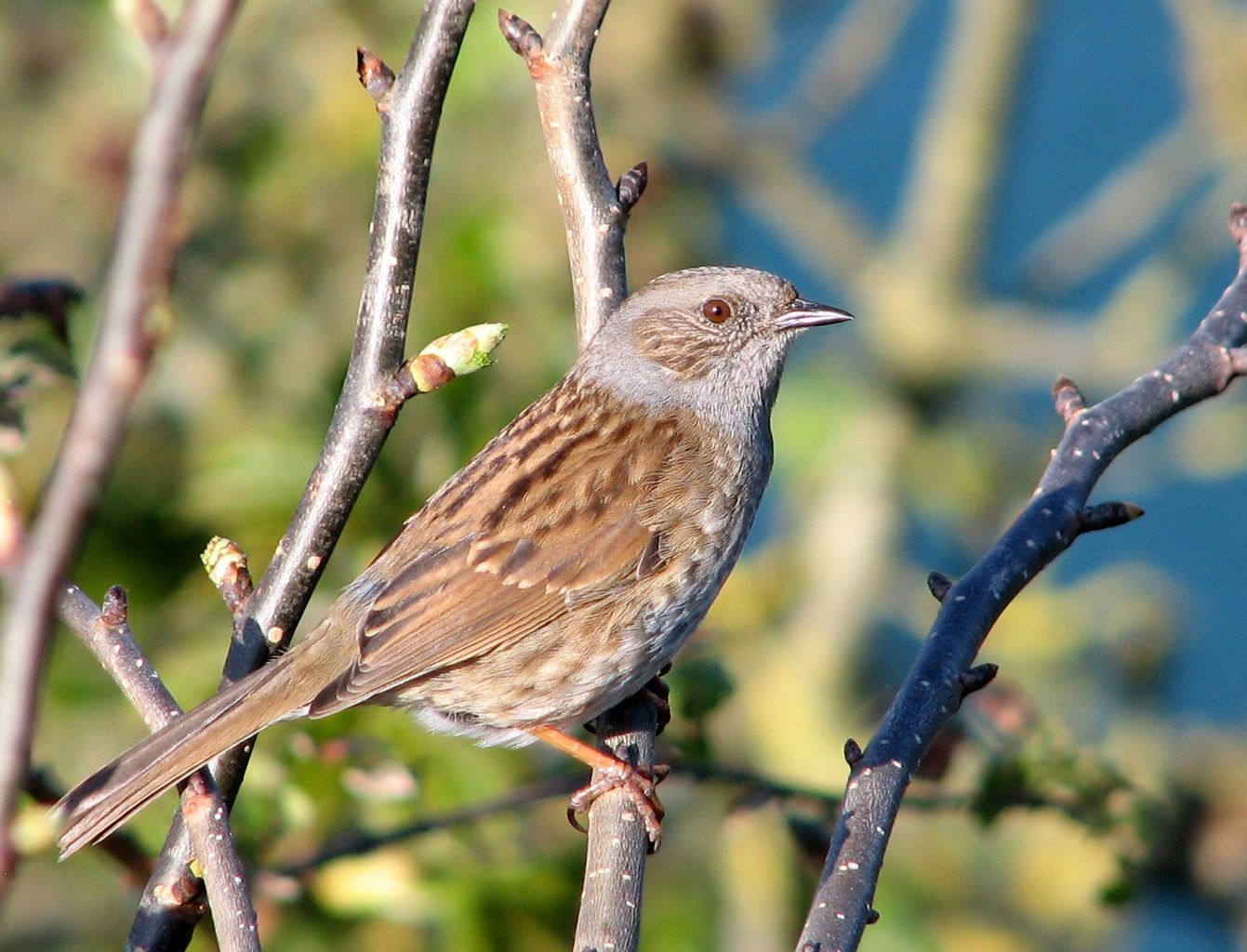 Dunnock ■■
Dunnock ■■ |
stereotype melodic fast high (4-8 KHz) .
General: High-pitched, repetitive but complex little tune. Song: |
♫

|
| mimicry | ||
|
|
mimicry stereotype melodic fast low-high (2-7 KHz) .
General: Aehnlich wie ein Rohrsaenger aber nur kurze Segmente mit klaren Pausen. Song: Nabu: Sein Gesang umfasst trillernde, kurze und musikalische pfeifende Laute, unter anderem „piUU“, „trrüh“ und „tu-ki-jüüh“. [Link] Song: |
♫

|
|
|
stereotype melodic slow low-high (2-8 KHz) .
3-note long M, pause, HL (somewhat falling)...Gim! Gim-peeel! Sounds a bit like a pirol.
Song: |
♫

|
| mimicry, trill | ||
 Rock bunting ■■
Rock bunting ■■ |
mimicry, trill stereotype melodic fast low-high (2-9 KHz) .
AppearanceAndIdentification: orange-brauner bauch, weisse brust+kopf mit 3 schwarzen streifen am kopf (unter/am/ueber Augen), braun+dunkelbraun auf Fluegeln; aber Weibchen eher braun
Song: Notes from 2022: Short song, relatively long pause, repeated with slight variation? Has a very short triller of just 3 notes. May have heard and seen one walking parallel to the Aa on the way to Pfaeffikersee today, though the visual ID is very uncertain; the Xeno-Canto song here sounds different than my 2022 description - musical like a chaffinch but rising, not falling. Song: |
♫

|
| one note | ||
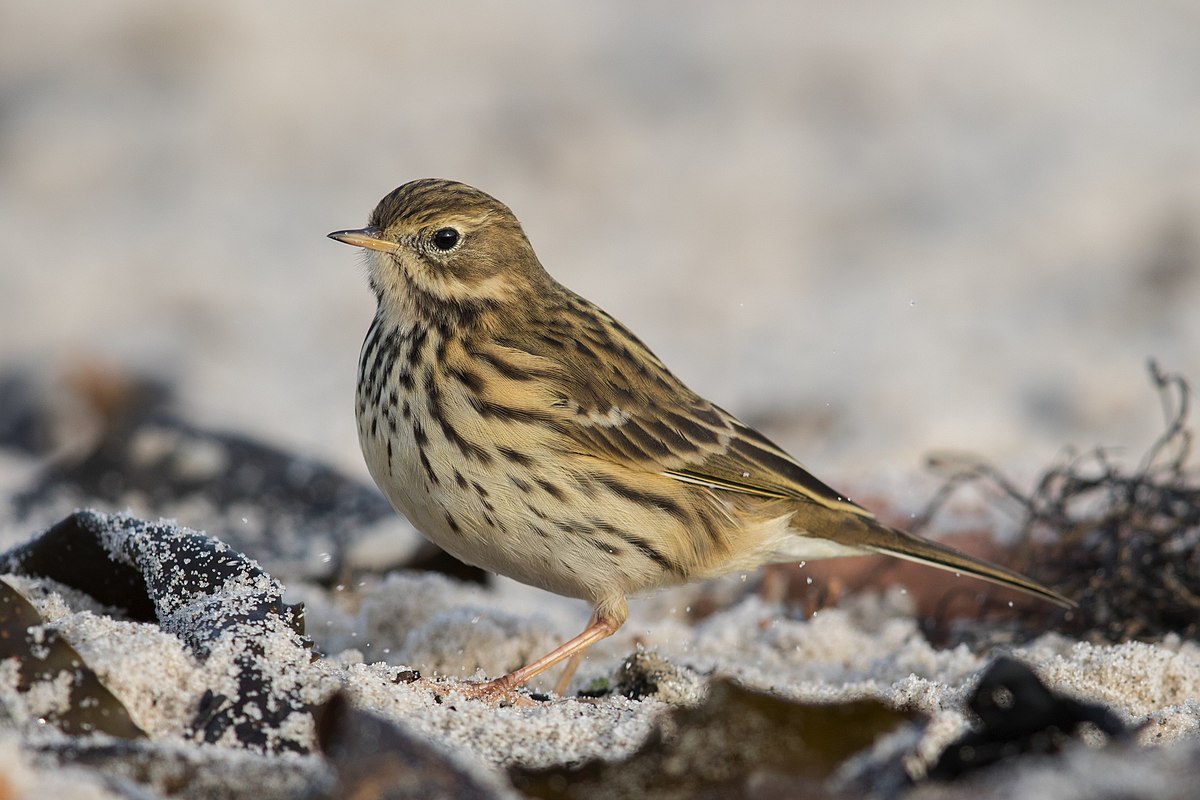 Meadow pipit ■■
Meadow pipit ■■ |
one note fast medium (1-5 KHz) .
Single note, possibly rising at the end. (Or: long 4 second phrases, gradually louder then softer; swoopy or whoopy.) Sings in flight. BirdID: Song very similar to Rock Pipit, but tone less full and more brittle. Lacks Rock Pipit's closing trill, and beginning is less "hammering". - but what does a rock pipit sound like?
Song: |
♫

|
| simple rhythmic | ||
| whoop, trill | ||
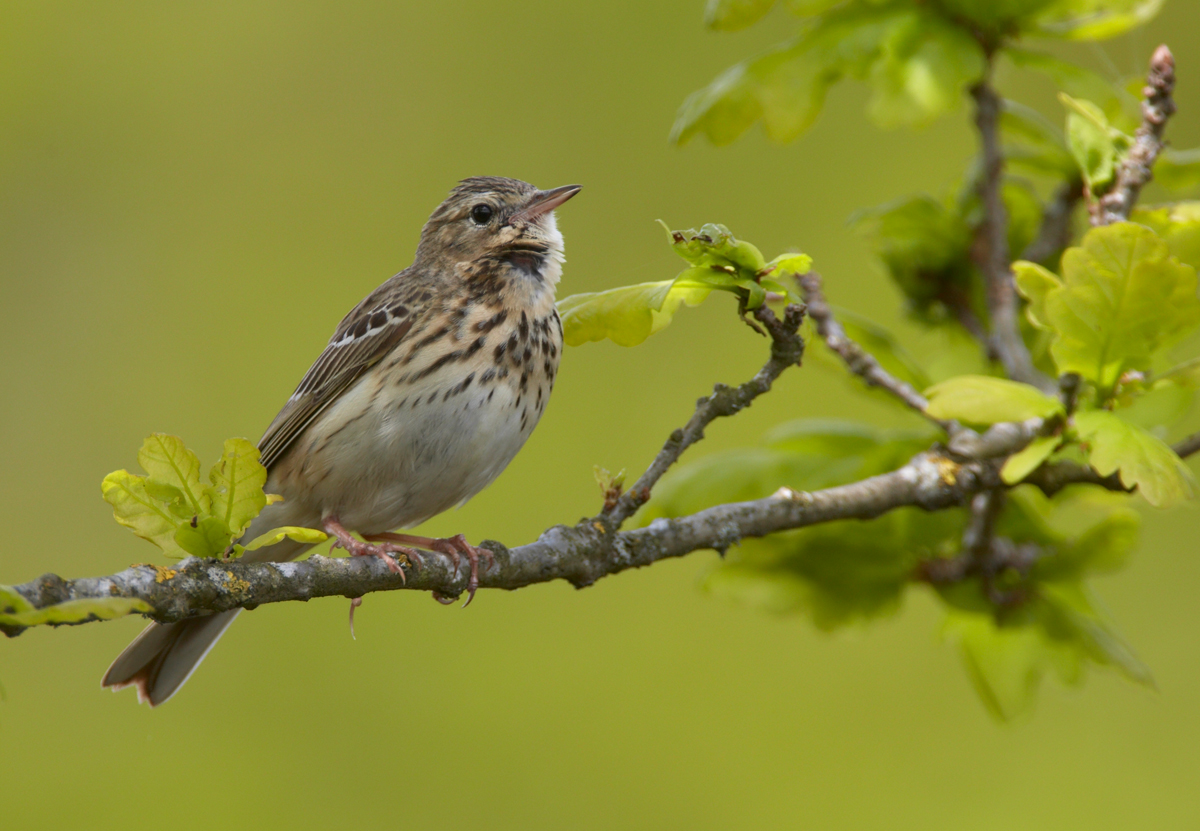 Tree pipit ■■
Tree pipit ■■ |
whoop, trill simple rhythmic slow medium (1-5 KHz) .
Reminds me of a greenfinch - series of trills, whoops and other sounds with a long pause
Song: |
♫

|
| one note | ||
|
|
one note fast high (3-7 KHz) .
|
♫

|
| simple rhythmic | ||
| mimicry | ||
 Common whitethroat ■■
Common whitethroat ■■ |
mimicry simple rhythmic fast high (3-7 KHz) .
Song: |
♫
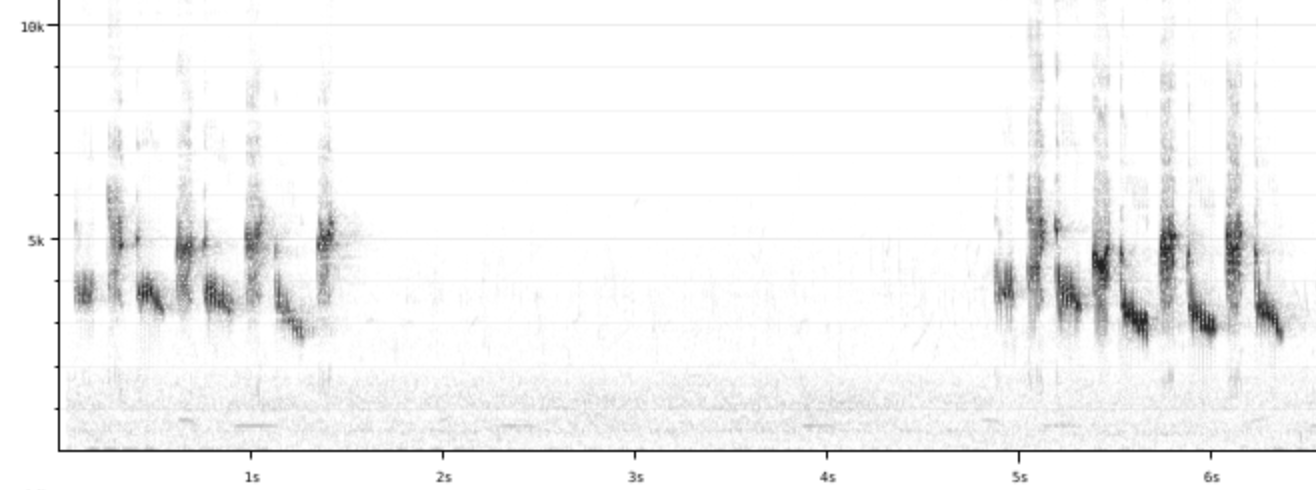
|
| trill | ||
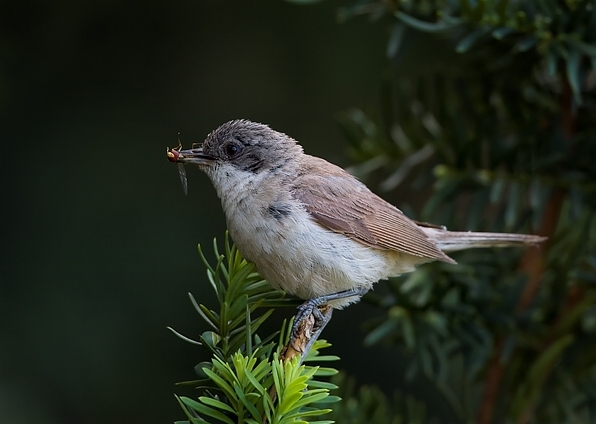 Lesser whitethroat ■■
Lesser whitethroat ■■ |
trill simple rhythmic slow medium (3-5 KHz) .
|
♫

|
| sings 30 seconds or longer | ||
| mimicry | ||
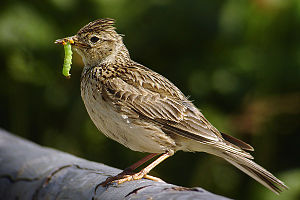 Eurasian skylark ■■
Eurasian skylark ■■ |
mimicry sings 30 seconds or longer slow medium (2-6 KHz) .
Fast chirpy improvization without a break, not very high, reminds me of a nightingale or a Eurasian reed warbler/Teichrohrsänger with the exact rhythm, but most likely sung in a cornfield. Or a Singdrossel that repeats its elements longer that that guy. Repeats elements 1-8 times. Sometimes buzzy/trilly. Can go on for minutes at a time. Ich habe es auch mit einem Amsel verwechselt, da er lang und melodisch, fast wie Amsel aber hört nicht auf.
Song: |
♫

|
| stereotype melodic | ||
|
|
stereotype melodic slow low-high (2-7 KHz) .
General: Usually just calls. This song is just a few chirpy slurs, sometimes rising-rising-falling. Song: |
♫

|
|
|
stereotype melodic slow high (3-9 KHz) .
Just a few notes, call seems to be common but song rare. Very short chirp of ~ 1 sec, long pause of 3 secs. At Wauwilermoos it seemed to be 'Twee tweetwee (higher note:) twee!'
Song: |
♫
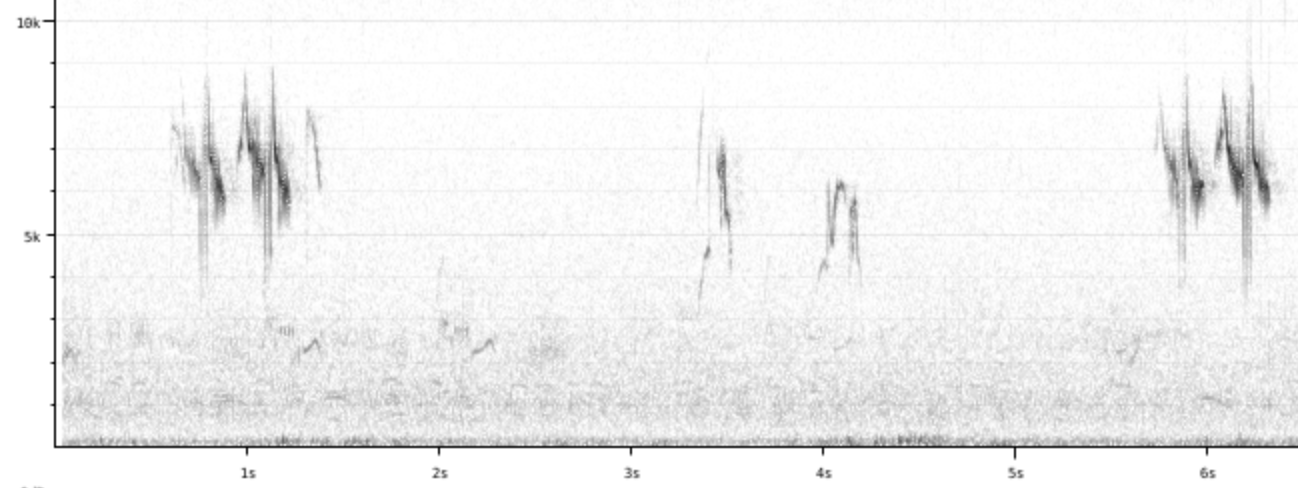
|
| trill | ||
|
|
trill stereotype melodic fast high (3-9 KHz) .
|
♫

|
| fluting, rattle | ||
|
|
fluting, rattle stereotype melodic fast low-high (2-7 KHz) .
General: Hectic sing-song, quite chaotic in feeding groups. But kept as songbird, so I guess more melodic when singing solo. A bit like a black cap warbler (Mönchsgrasmücke). Gesang hat eine Struktur (und ist langsamer als der Girlitz): Zuerst eine kleine Melodie hoch und runter; dann vielleicht ein Gruenfink-Triller, dann 4 wiederholte Noten oder ein neues Melodiechen. (Oder kommen diese Elemente eher zufaellig?) Song: Name stammt angeblich vom Gesang: ein steigernder sti-ge-litt. My first (multilingual) notes: Stieglitz like Grünfink, fast, high, occasional trills. Occasionally ends a bit with falling note like buchfink Mir wurde erst in St. Moritz in Juli 2021 bewusst wie aehnlich der Steiglitz wie ein Gruenfink klingt - beide koennen lange Gesang mit Trillern und rauhen sinkenden Toenen singen, und ich habe Stieglitz v.a. durch dieses Stoehnen fuer Gruenfink gehalten. |
♫

|
| sings 5-19 seconds | ||
 European serin ■■
European serin ■■ |
sings 5-19 seconds veryFast high (4-10 KHz) .
Song: Weird hectic song, and you'll probably hear them but not see them, which is a shame, because they're a colorful yellow bird. The song seems to defy description - described variously as the jingling of a bunch of keys, like crushing glass or the pouring of broken glass (the German Wikipedia refers to a nickname 'Glasscutter'), the sound of a cork twising in a bottle (Thomas Seilnacht on digitalefolien.ch), and one source I can no longer find talked about a ruined cassette tape. A Portuguese web site aptly calls it 'a high-pitched and fast rambled sum of indistinctive elements', and U. Cornell's ebird.org calls it frantically fast, oiseaux-birds.com 'a prolonged, wheezy, chirping', beautyofbirds.com 'a buzzing trill'. |
♫

|
| stereotype melodic | ||
| trill | ||
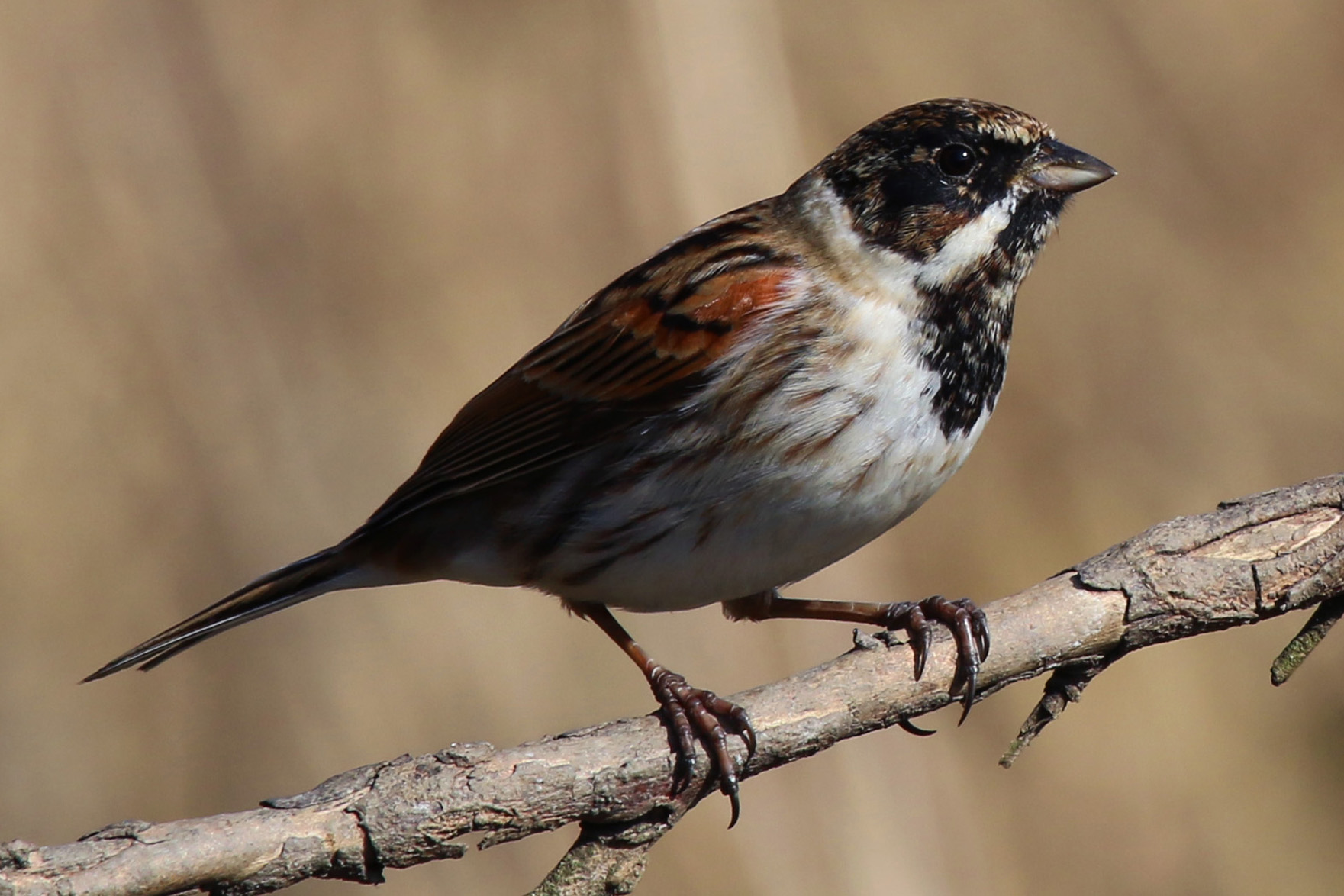 Common reed bunting ■■
Common reed bunting ■■ |
trill stereotype melodic slow high (3-7 KHz) .
General: At Fanel I heard sequences of whistles and trills (buzzes?), just a few notes, but wandering up and down: m h lll, or l m hhh m. Listen to recording of 2022-06-25 13.37.28 Song: |
♫

|
Practice
♫ Answer
Grey wagtail
♫
Answer
Grey wagtail
♫
 Answer
Common reed bunting
♫
Answer
Common reed bunting
♫
 Answer
White-throated dipper XC512901-Wasseramsel.
♫
Answer
White-throated dipper XC512901-Wasseramsel.
♫
 Answer
Meadow pipit
♫
Answer
Meadow pipit
♫
 Answer
European goldfinch
♫
Answer
European goldfinch
♫
 Answer
European serin
♫
Answer
European serin
♫
 Answer
Lesser whitethroat
♫
Answer
Lesser whitethroat
♫
 Answer
Rock bunting
♫
Answer
Rock bunting
♫
 Answer
Short-toed treecreeper
♫
Answer
Short-toed treecreeper
♫
 Answer
Wood lark
♫
Answer
Wood lark
♫
 Answer
Tree pipit
♫
Answer
Tree pipit
♫
 Answer
Water pipit
♫
Answer
Water pipit
♫
 Answer
Eurasian skylark
♫
Answer
Eurasian skylark
♫
 Answer
Red-backed shrike
♫
Answer
Red-backed shrike
♫
 Answer
Common whitethroat
♫
Answer
Common whitethroat
♫
 Answer
Common nightingale
♫
Answer
Common nightingale
♫
 Answer
Eurasian bullfinch
♫
Answer
Eurasian bullfinch
♫
 Answer
Great reed warbler
♫
Answer
Great reed warbler
♫
 Answer
Marsh warbler
♫
Answer
Marsh warbler
♫
 Answer
Dunnock XC778759 - Dunnock - Prunella modularis - song recorded in Spain.
♫
Answer
Dunnock XC778759 - Dunnock - Prunella modularis - song recorded in Spain.
♫
 Answer
Common linnet
♫
Answer
Common linnet
♫
 Answer
Eurasian reed warbler
♫
Answer
Eurasian reed warbler
♫
 Answer
Eurasian treecreeper XC656422 - Eurasian Treecreeper - Certhia familiaris - song, recorded in Sweden.
♫
Answer
Eurasian treecreeper XC656422 - Eurasian Treecreeper - Certhia familiaris - song, recorded in Sweden.
♫
 Answer
Jackdaw XC604997 - Western Jackdaw - Coloeus monedula - call, recorded in England.
♫
Answer
Jackdaw XC604997 - Western Jackdaw - Coloeus monedula - call, recorded in England.
♫
 Answer
Western yellow wagtail
♫
Answer
Western yellow wagtail
♫
 Answer
Western bonelli's warbler
♫
Answer
Western bonelli's warbler
♫
 Answer
White wagtail
Answer
White wagtail
Birds with insufficient information about songs/calls
| Bird | Description | Audio |
|
|
Call: | |
|
|
Song: | |
| improvised melodic | ||
| trill | ||
 Melodious warbler ■■
Melodious warbler ■■ | trill improvised melodic veryFast low-high (2-8 KHz) . Repeats bits 6-9 times, makes pauses, but also sings like mad with a distorted chirpy voice. Sometimes sings a descending trill that could be a giveaway. Can sing low (2k) or fairly high (8k) |
♫
|
| sings 30 seconds or longer | ||
| mimicry | ||
|
| mimicry sings 30 seconds or longer slow medium (1-5 KHz) . Reminds me a bit of a Rohrsaenger/Feldlerche with its short, varied bits. BirdID says Song surprisingly varied with many expert imitations of small passerines, interwoven with bell-like ringing and dry chirping sounds. May be confusing and hard to identify if bird not seen. Song not very loud, but phrases can be very long. 'May be confusing' - tell me about it! What's not confusing about trying to tell apart 422 species of Swiss birds! |
♫

|
|
|
.
Automatically generated from Xeno-Canto recording
Call: Nabu: Ein hartes „kjack“ oder „schack“ sowie ein raues „tschräh“ hört man am häufigsten von der Dohle. Sie ist ein begabtes Stimmwunder und hat eine Vielzahl von Lauten und Imitationen auf Lager. [Link] |
♫

|